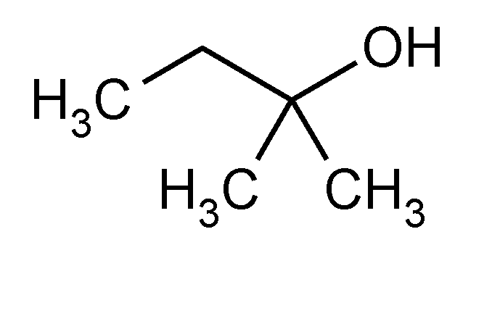Amylene Hydrate
» Amylene Hydrate contains not less than 99.0 percent and not more than 100.0 percent of C5H12O.
Packaging and storage—
Preserve in tight containers.
Identification—
A:
Mix 2 mL with 15 mL of water, 5 mL of sulfuric acid, and 10 g of potassium dichromate, heat the mixture under a reflux condenser for 2 hours, and then distil, collecting and reserving the first 2 mL of the distillate. Continue the distillation until most of the water has distilled over, render this distillate alkaline with 1 N sodium hydroxide, add 2 N sulfuric acid dropwise until the solution is neutral to litmus, and carefully evaporate to dryness: the residue responds to the tests for Acetate  191
191 .
.
B:
To 1 mL of the reserved distillate obtained in Identification test A add 5 drops of sodium nitroferricyanide TS and 2 mL of 1 N sodium hydroxide, then add a slight excess of 6 N acetic acid: a deep red liquid, which develops a violet tint when diluted with several volumes of water, is produced.
C:
To 10 mL of a solution (1 in 10) quickly add 5 mL of a 1 in 100 solution of vanillin in sulfuric acid: a violet-red color is produced.
Specific gravity  841
841 :
between 0.803 and 0.807.
:
between 0.803 and 0.807.
Distilling range, Method I  721
721 —
It distills completely between 97
—
It distills completely between 97 and 103
and 103 , a correction factor of 0.037
, a correction factor of 0.037 per mm being applied as necessary.
per mm being applied as necessary.
Water—
The relative retention time of water on the gas chromatographic column used in the Assay is approximately 0.2 times that of Amylene Hydrate. From the area under the curve obtained in the Assay, calculate the percentage (a/a) of water in the Amylene Hydrate taken: not more than 0.5% is found.
Limit of nonvolatile residue—
Evaporate 10 mL in a tared porcelain dish on a steam bath to a volume of about 1 mL, and allow it to evaporate spontaneously to dryness while protected from dust: the residue, if any, is colorless, and, when dried at 105 for 1 hour, weighs not more than 2 mg (0.02%).
for 1 hour, weighs not more than 2 mg (0.02%).
Heavy metals, Method I  231
231 —
Evaporate 5.0 mL (4 g) on a steam bath to dryness, warm the residue gently with 1 mL of dilute hydrochloric acid (1 in 120), add water to make 25 mL, and filter, if necessary: the limit is 0.0005%.
—
Evaporate 5.0 mL (4 g) on a steam bath to dryness, warm the residue gently with 1 mL of dilute hydrochloric acid (1 in 120), add water to make 25 mL, and filter, if necessary: the limit is 0.0005%.
Readily oxidizable substances—
To 10 mL of a solution (1 in 20) add 0.10 mL of 0.10 N potassium permanganate: the pink color does not completely disappear within 10 minutes.
Aldehyde—
To 10 mL of a solution (1 in 20) add 1 mL of silver-ammonium nitrate TS, and heat the mixture on a water bath at 60 for 10 minutes: no darkening occurs.
for 10 minutes: no darkening occurs.
Assay—
Inject 0.4 µL of Amylene Hydrate into a suitable gas chromatograph (see Chromatography  621
621 ) equipped with a thermal conductivity detector. Under typical conditions, the instrument contains a 4-mm × 2-m glass column packed with chromatographic support S2. The column is maintained at a temperature of 190
) equipped with a thermal conductivity detector. Under typical conditions, the instrument contains a 4-mm × 2-m glass column packed with chromatographic support S2. The column is maintained at a temperature of 190 , the injection port is maintained at about 200
, the injection port is maintained at about 200 , the detector block is maintained at about 200
, the detector block is maintained at about 200 , and helium is used as a carrier gas at a flow rate of about 50 mL per minute. From the area under the curve, calculate the percentage (a/a) of C5H12O in the Amylene Hydrate taken.
, and helium is used as a carrier gas at a flow rate of about 50 mL per minute. From the area under the curve, calculate the percentage (a/a) of C5H12O in the Amylene Hydrate taken.
Auxiliary Information—
Please check for your question in the FAQs before contacting USP.
Chromatographic Column—
| Topic/Question | Contact | Expert Committee |
| Monograph | Robert H. Lafaver, B.A.
Scientist 1-301-816-8335 |
(EM105) Excipient Monographs 1 |
USP32–NF27 Page 1166
Chromatographic columns text is not derived from, and not part of, USP 32 or NF 27.
